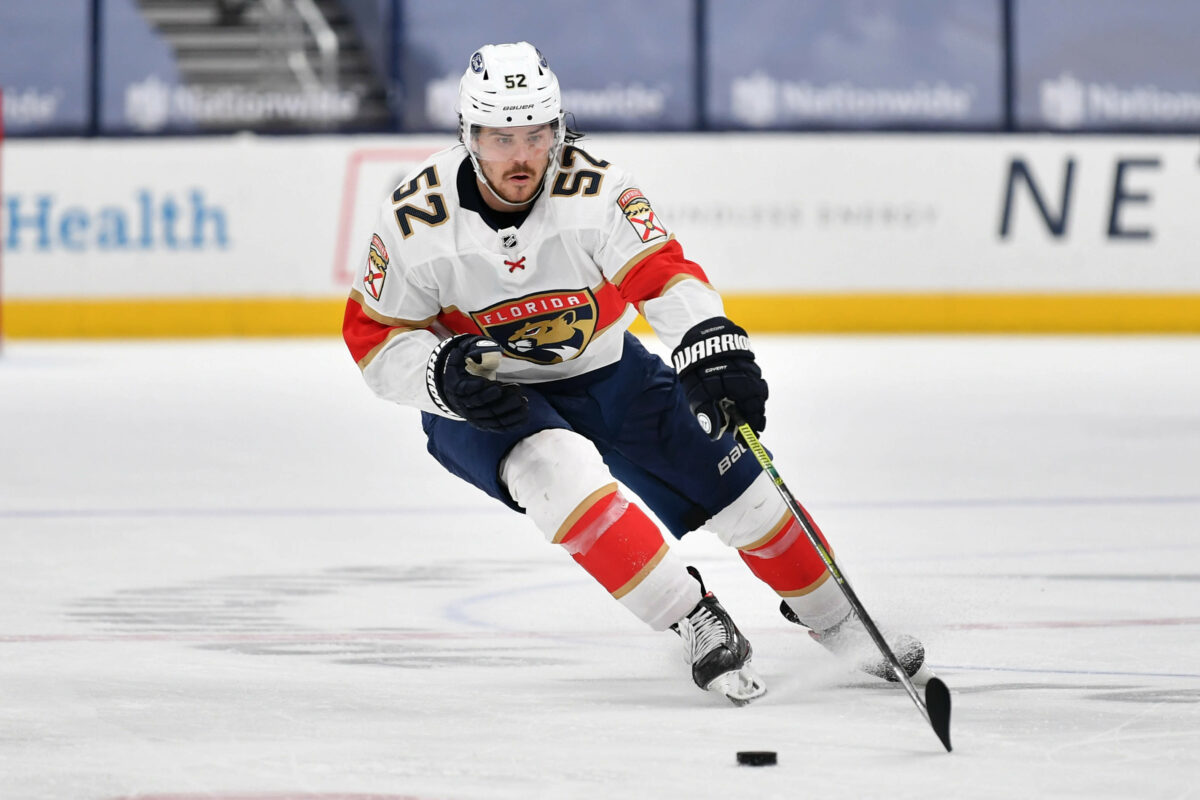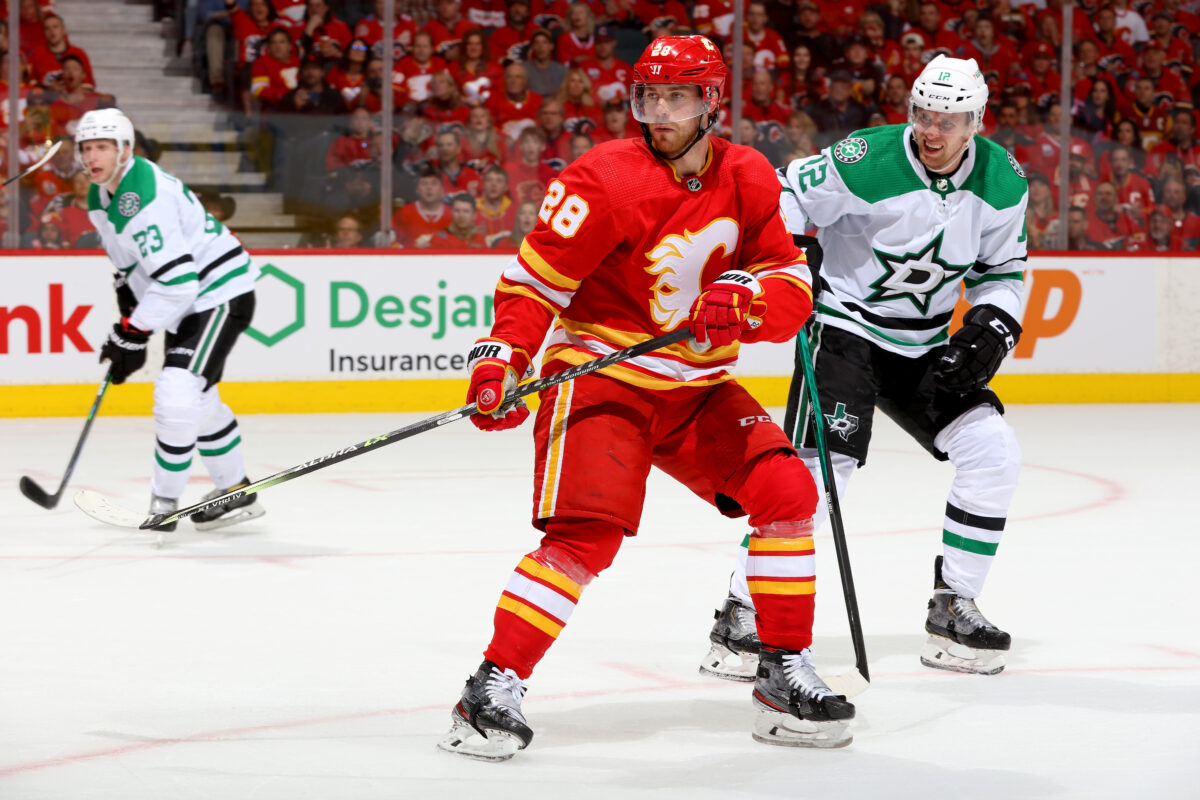The Calgary Flames capped off an incredible offseason with the signing of MacKenzie Weegar. This not only makes them the clear winner of the summer blockbuster trade, but gives a great look at what the future will be like in Calgary for the next number of years.
All three very good players the Flames acquired this offseason are now under contract for at least the next seven years. Nazem Kadri is signed for seven years with an average annual value (AAV) of $7 million while Jonathan Huberdeau has one year left on his current deal before getting a significant pay raise to $10.5 million AAV for eight years. Weegar will be sticking around Calgary for just as long as his eight-year contract kicks in next season with an AAV of $6.25 million. These three players will make up a key part of the core for the Flames and create a core to build around.
How the Flames’ Long-Term Deals Will Look Like Near the End
As with most long-term contracts given to players in their late 20s or early 30s, it is about the next five or so years, not the end of the deals. Kadri will be under contract until he is 39, Huberdeau until he is 38, and Weegar until he is 37. It’s not a guarantee that all of them will become very ineffective at that age either. It could go well or very bad.
Defence are less likely to have a major drop-off, especially defensively capable ones who can put their focus into defending rather than producing points. Weegar has this potential and will be the youngest at the end of his deal. With the smaller cap hit as well, there is a strong chance he spends the entire nine seasons with the Flames and is a major part of any success in a top-four role the entire way.

Both Huberdeau and Kadri are coming off of career years, so that definitely played a part in the contracts they were given. Like Johnny Gaudreau or Artemi Panarin before him, an elite playmaking left wing is valued very highly and would have gotten the attention of a number of teams next offseason if he wasn’t locked up with Calgary. Regardless of whether Huberdeau had a career year or not in 2021-22, he has still posted over a point per game in four consecutive seasons now. He hangs around the Hart Trophy conversation and is one of the best passers in the league. That’s what the Flames will expect from their top paid player and what he can deliver.
Related: Flames’ Sutter Praises Huberdeau, Takes Subtle Shot at Gaudreau
The Flames may only be able to expect that high level of performance from Huberdeau until he’s 35 or 36, but he has never been one to utilize speed over skill to produce. This will make his offensive decline less impactful in the distant future since he will be able to hold onto his vision on the ice and passing ability.
The biggest concern is that Kadri won’t finish his contract with the Flames, but this concern shouldn’t be at the forefront of management’s mind until they start to see actual decline. A step back from his performance last season will be completely normal considering the offensive group around him in Colorado. That shouldn’t be used as an indication he’s already declining. The Flames don’t know which version of Kadri they are going to get. Will it be the player who scored more goals than assists and was able to top the 30-goal mark in a season, or the playmaking centre who earns Selke votes?
You may also like:
- Projected Lineups for the Canucks vs Flames– 12/31/24
- One Burning Question for Every NHL Team in 2025
- Flames Have High-Priority Free Agents To Sign
- 3 Bold Predictions for the Calgary Flames in 2025
- Projected Lineups for Flames vs Golden Knights – 12/29/24
A combination of both would do the Flames the best. If Kadri continues to play a strong two-way game, they will have three centermen who can defend very well. It will provide the Flames with even more goalscoring on the second line if he can score as well as provide Andrew Mangiapane with a playmaker to set him up for goals. His goalscoring is also needed to maintain a level of scoring from the lines other than the first. Kadri’s all-around game could start to dwindle quicker than the other two considering he’s already 32 years old. He scored at nearly a 0.4 goals-per-game rate last season, which is in line with the best in his career. He has also scored at just a 0.2 goals-per-game rate in two of the past four seasons. The hope is that his production doesn’t head that direction any time soon, but it likely will in a few years.
Flames’ Window to Win
Given the long-term contracts, mid-length contracts, and deals ending in two years, the Flames still have a pretty solid window to make something happen and win the Stanley Cup. At the very least, they have the next two years considering a number of players, including Mikael Backlund, Elias Lindholm, Tyler Toffoli, Dylan Dube, Adam Ruzicka, Noah Hanifin, Chris Tanev, Nikita Zadorov, Oliver Kylington, Jakob Pelletier, Adam Klapka, and Dustin Wolf will all need new deals, whether they are unrestricted free agents or restricted free agents. All of these players will also not be returning, but some have a positive impact on the team winning now and others by the time their deals are up.

At the very most, the Flames’ window to win lasts the entire length of Huberdeau and Weegar’s contracts, which is nine years. But that is very optimistic because there are so many variables that can change the outcome of a team or league by that time. All the Flames can hope for is that they haven’t had to rebuild by that time and are still giving themselves a chance to win by qualifying for playoffs.
The most likely window to win for the Flames is four to five years. On top of the three top players signed long term, there are three more key players currently under contract for four more years, Rasmus Andersson, Blake Coleman, and Jacob Markstrom. Andersson is young enough and he will be in his prime while still under contract. The other two are older, but Coleman provides great two-way play on the third line and Markstrom is currently a Vezina Trophy hopeful with the level of play he provides. Wolf will also have emerged as the likely next number one, allowing for the Flames’ window to potentially stay open after Markstrom’s departure.
A large portion of the core will be intact in four years time, and all of the players who have two years remaining on their deals won’t be gone either. Brad Treliving has already made a case for general manager of the year before the season has started. He saved the team and has brought hope to Calgary in the hopes this strong group can bring a Stanley Cup back to Canada.